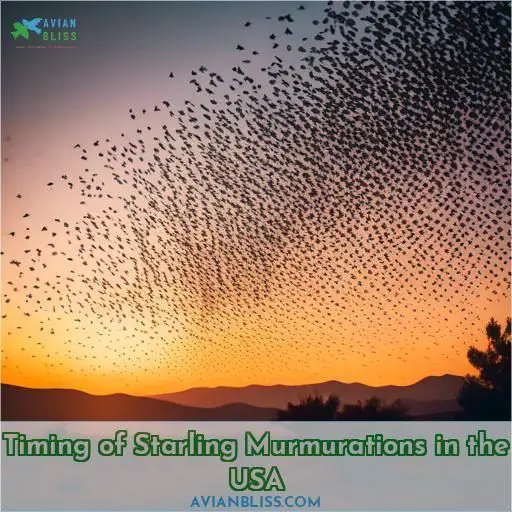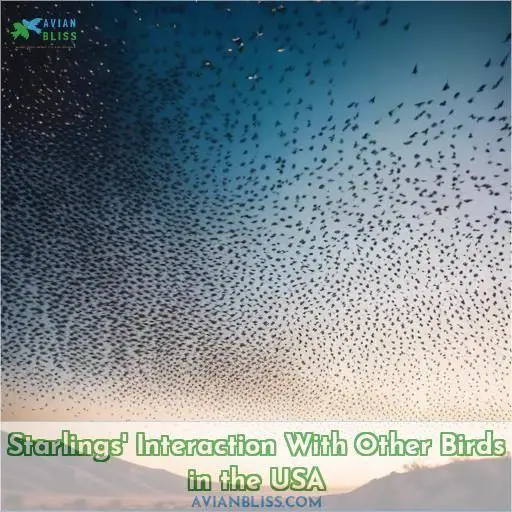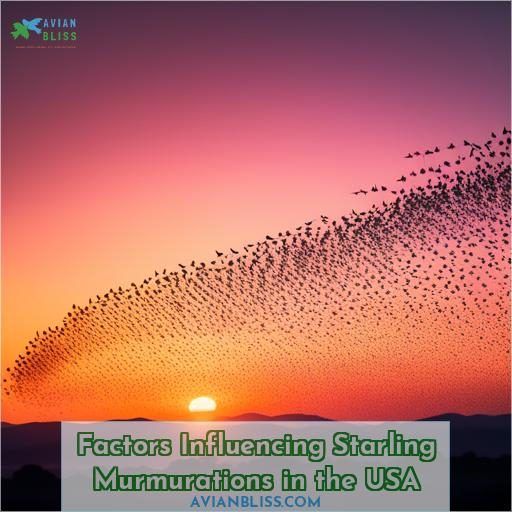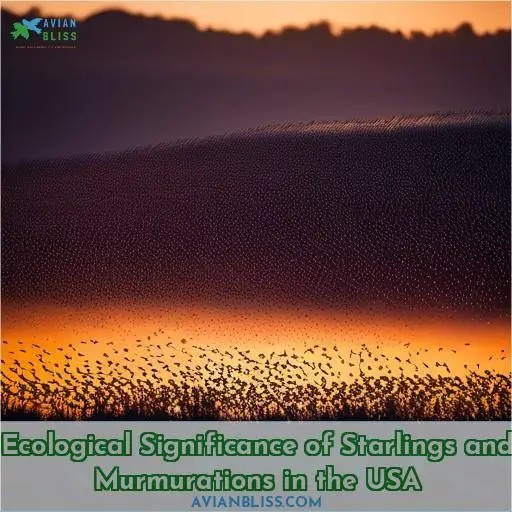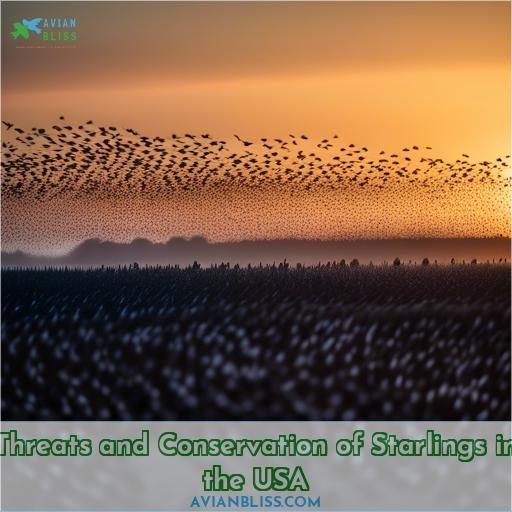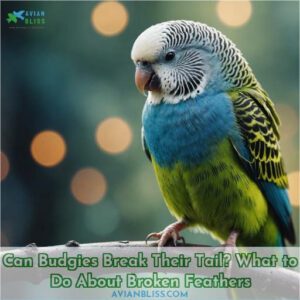This site is supported by our readers. We may earn a commission, at no cost to you, if you purchase through links.
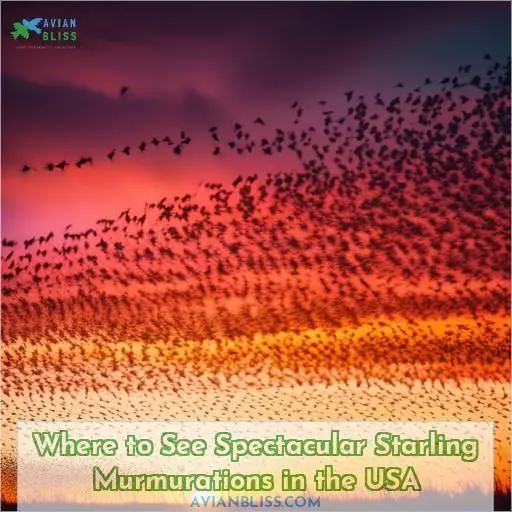
To witness spectacular starling murmurations in the USA, you’ll find prime spots like Central Park in New York City, Saguaro National Park and Cave Creek Canyon in Arizona, Acadia National Park in Maine, and Sax-Zim Bog in Minnesota.
These locations offer ideal habitats and large starling populations that engage in mesmerizing aerial ballets just after dusk from November to February.
As thousands of starlings swirl in shape-shifting clouds, their synchronized movements are a jaw-dropping sight to behold.
To investigate the intricate dynamics behind this fascinating phenomenon, let’s delve deeper.
Table Of Contents
- Key Takeaways
- Where to See Starling Murmuration in the Usa?
- Starling Murmurations in the USA
- Best Places to See Starling Murmurations in the USA
- Timing of Starling Murmurations in the USA
- Seasonal Patterns of Starling Murmurations
- Starling Roosting Behavior in the USA
- Starlings’ Interaction With Other Birds in the USA
- Starling Flocking Dynamics in the USA
- Factors Influencing Starling Murmurations in the USA
- Ecological Significance of Starlings and Murmurations in the USA
- Threats and Conservation of Starlings in the USA
- Frequently Asked Questions (FAQs)
- Conclusion
Key Takeaways
- Starling murmurations in the USA are a mesmerizing sight, occurring between November and February, just after dusk.
- Central Park in New York City, Saguaro National Park in Arizona, and Acadia National Park in Maine are prime locations to witness these aerial displays.
- Starlings engage in murmurations for safety in numbers, warmth sharing, and aerobic display.
- Conservation efforts are crucial to protect starlings and their habitats, as they play a vital role in nutrient cycling and seed dispersal.
Where to See Starling Murmuration in the Usa?
In the USA, you can witness the breathtaking starling murmurations in locations such as California, New York, Wisconsin, and the San Rafael area of the North Bay in the San Francisco Bay Area. These natural spectacles occur mainly between November and December, offering a mesmerizing view of starlings moving in unison.
Starling Murmurations in the USA
Starling murmurations in the USA are an intriguing phenomenon that involves large groups of starlings flying in coordinated patterns. These aerial displays are both visually striking and serve various purposes, including defense against predators, warmth during cold evenings, and social gatherings. Starlings are renowned for their mimicry abilities, which play a vital role in their social interactions and mating rituals.
While starlings can be beneficial by controlling insect populations, their large numbers can result in substantial crop damage and noise in populated areas. Their impact on agriculture and urban areas is double-sided, balancing between being helpful and problematic. Starlings are adaptable to a wide range of habitats, from seacoast cliffs to farm fields and meadows to urban environments.
In the USA, starlings are most noticeable among the pest birds, as they can pose a threat to native bird species and crops. They’ve been introduced to many countries outside of their native range and are considered invasive in some areas. Despite their widespread presence and occasionally contentious impact on native wildlife and human activities, starlings remain a symbol of adaptability and intelligence in the avian world.
Best Places to See Starling Murmurations in the USA
If you’re seeking to experience the enthralling spectacle of starling murmurations in the USA, you’re in fortune. From Central Park in New York City to the Saguaro National Park in Arizona, these prime locations offer some of the most exceptional opportunities to observe these enchanting natural displays.
Central Park, New York City
Central Park, New York City is a prime location to witness starling murmurations. Here’s why:
- Starling Population: Central Park hosts a significant starling population, making it a hub for murmuration sightings.
- Urban Adaptation: Starlings have adapted to urban environments, making Central Park an ideal location for their roosting and feeding.
- Light Pollution: Despite the city’s light pollution, starlings are still able to navigate and form murmurations, showcasing their adaptability.
- Citizen Science: Participate in citizen science projects to observe and document starling behavior in Central Park, contributing to scientific research.
Saguaro National Park, Arizona
Saguaro National Park in Arizona is a prime location to witness starling murmurations. These shape-shifting congregations of birds occur before roosting, typically between November and February, and are characterized by their continuous, low humming sound.
Starling behavior is influenced by predation effects, habitat conservation, climate impacts, and disease spread. Visitors can observe these dynamic displays in the park’s open spaces, woodlands, and cliffs, often in the presence of other bird species such as geese, robins, and flamingos.
The best time to see murmurations is mid-autumn to winter, just after dusk, when starlings gather in large numbers for protection from predators, information exchange, warmth sharing, predator confusion, and aerobatic display.
Cave Creek Canyon, Arizona
Cave Creek Canyon, Arizona, is another prime location for starling murmuration sightings. Follow birdwatching etiquette, respecting wildlife and their habitats. Visit local guides and visitor centers for insights. Capture stunning wildlife photography of the flock’s dynamic movements. Remember, patience and observation are key to witnessing these awe-inspiring roosts.
Acadia National Park, Maine
Acadia National Park, located in coastal Maine, is a popular destination for park visitors seeking to enjoy the park’s natural beauty and learn about its history. The park’s scenic landscape, which includes forests, wetlands, and coastlines, is a natural laboratory for studying the park’s ecosystems and the impact of human activities on the environment.
One of the most notable aspects of Acadia National Park is the presence of starling murmurations. These large flocks of starlings can be seen in the park during the winter months, typically between November and February. The term murmuration stems from the continuous, low humming sound produced by the flock. Starling murmurations are believed to serve several purposes, such as safety in numbers, confusion, warmth sharing, and aerobatic display.
To see starling murmurations in Acadia National Park, visitors should plan their trip during mid-autumn to winter, just after dusk. The best locations to view these spectacles include large, open areas, woodlands, cliffs, and parks. Some prime locations within the park include the coastal areas, where starlings can be seen roosting in large numbers.
Acadia National Park is a significant contributor to the local economy, generating $479 million in spending and supporting nearly 6,700 jobs in the area in 2022. Tourism to the park is a critical driver of the local economy, bringing jobs and revenue to communities within 60 miles of the park.
In addition to starlings, other bird species can be found in Acadia National Park, such as geese, robins, dunlins, raptors, and flamingos. These birds also exhibit flocking behavior, which can be observed in their V-shaped flight patterns.
Visitors to Acadia National Park should be aware of the park’s environmental impact and adhere to guidelines for responsible tourism. This includes practicing Leave No Trace principles, respecting wildlife, and staying on designated trails. By doing so, visitors can help guarantee the park’s natural resources are protected for future generations to enjoy.
Sax-Zim Bog, Minnesota
At Minnesota’s Sax-Zim Bog, witness starlings’ aerial ballet, echoing schools of fish. Their vocalizations enhance winter birding, perfect for wildlife photography amidst bog ecology and ongoing conservation efforts.
Bosque Del Apache National Wildlife Refuge, New Mexico
Bosque Del Apache National Wildlife Refuge in New Mexico is another prime location to witness starling murmurations. This refuge is situated in central New Mexico and is known for its diverse wildlife and stunning landscapes. Here are four reasons why it’s a must-visit:
- Impact on Tourism: The murmurations attract birdwatchers and nature enthusiasts, boosting local tourism.
- Cultural Significance: The murmurations have cultural significance for local Native American tribes.
- Economic Benefits: The refuge’s popularity contributes to the local economy through tourism and wildlife-related businesses.
- Educational Opportunities: Visiting the refuge provides educational opportunities for students and researchers.
Timing of Starling Murmurations in the USA
Timing is paramount when it comes to experiencing the mesmerizing spectacle of starling murmurations in the USA. These flocks of birds gather in large numbers just after dusk, typically between November and February.
The term murmuration stems from the continuous, low humming sound produced by the flock as they move in the sky. Safety in numbers, confusion, and warmth are potential reasons for this behavior.
Each starling moves to maintain a safe distance from its nearest neighbors, making adjustments to maintain an optimum density, avoiding total opacity. Starlings can see light areas (patches of sky) to gather essential information about their surroundings, which is entirely instinctive.
Seasonal Patterns of Starling Murmurations
Starling murmurations in the USA typically occur during the mid-autumn to winter months, just after dusk. This is the prime time to witness these mesmerizing aerial displays as starlings gather in large numbers to roost for the night.
Mid-autumn to Winter
As you’ve learned, timing is crucial for witnessing the awe-inspiring starling murmurations in the USA. These seasonal patterns reach their peak from mid-autumn to winter, a period when starlings gather in immense numbers. Imagine the sky as a canvas, with starlings painting ever-changing patterns:
- Flocks swell as starlings join for their autumnal ballet.
- Roosting behavior intensifies as the chill of winter’s approach draws near.
- Flocking dynamics are fine-tuned, a dance of coordination and survival.
- Ecological significance grows, as does the urgency for conservation.
- Witnessing murmurations becomes a symbol of nature’s rhythm and resilience.
Just After Dusk
Just after dusk, you’ll find starlings engaging in their mesmerizing murmurations. These dynamic displays are driven by safety in numbers, warmth sharing, and aerial acrobatics.
Under clear, calm, cold conditions, starlings form dense flocks to maintain a safe distance from their neighbors. Each bird constantly monitors the trajectories of six to seven closest neighbors, making adjustments to maintain an optimum flock density.
The result is a striking spectacle that ends with a collective decision to descend to their roosts.
Starling Roosting Behavior in the USA
Starling roosting behavior in the USA is a fascinating aspect of their life cycle. These birds are known for their unique roosting sites, which can range from reedbeds to large buildings with ledges, woods, and cliffs. Starlings often switch roost sites, making their roosting behavior dynamic and unpredictable.
To see starling murmurations in the USA, it’s best to visit locations like Central Park in New York City, Saguaro National Park in Arizona, and Bosque del Apache National Wildlife Refuge in New Mexico. These sites offer prime opportunities to observe these mesmerizing displays, which typically occur in mid-autumn to winter, just after dusk.
Starlings’ Interaction With Other Birds in the USA
While starlings are the stars of the show, they’re not the only birds that put on an aerial display. Geese, robins, dunlins, raptors, and even flamingos have been known to flock together, creating V-shaped patterns that confuse predators.
Geese
Geese join the flocking party with their V-shaped patterns, adding to the spectacle of starling murmurations. These birds also flock to confuse predators, similar to starlings.
Geese are found in various habitats, such as Patagonia-Sonoita Creek Preserve and Merritt Island National Wildlife Refuge. They share the sky with starlings at Higbee Beach and Delaware Bay, and even in New Jersey, where they add to the aerial ballet.
Robins
When you’re out exploring the wonders of nature, remember to keep an eye out for our avian comrades, especially the robins. These birds aren’t merely captivating to observe but also fulfill a crucial purpose in the ecosystem. Robins are renowned for their migratory patterns, which can vary depending on their locale and environmental conditions.
In North America, robins are found far and wide, from Alaska to Mexico, and even in Europe as infrequent visitors. They migrate in small steps, often traveling only a few kilometers from their breeding grounds. Their migration is primarily motivated by the availability of sustenance, particularly invertebrates and fruit.
Robins are known to roost in a variety of spots, including trees, shrubs, and even birdhouses. During the breeding season, they’re more territorial, but in the winter, they tend to gather together to feed. They’re also known to form flocks, which can number in the hundreds.
When it comes to conservation, it’s essential to recognize that robins aren’t guarded by federal or state wildlife laws, and they can cause damage to crops and spread invasive seeds and diseases. However, humane pest control methods, such as traps, repellents, and deterrents, can be used to manage their population.
Dunlins
Dunlins join the starling murmuration party in the USA, contributing to the intricate patterns and behaviors. Here are three key points about their involvement:
- Dunlins form V-shaped patterns, unlike the complex shapes of starlings, but still flock to confuse predators.
- They interact with starlings and other birds, sharing information and coordinating movements.
- Dunlins are opportunistic feeders like starlings, consuming insects and invertebrates, and contribute to the nutrient cycling in their ecosystem.
Raptors
Raptors play a vital role in the starling ecosystem. As predators, they influence starling behavior and survival. Starlings have evolved to avoid predation by raptors, which can be seen in their flocking behavior. When starlings are in open spaces, they’re more vulnerable to aerial attacks from raptors. To counter this, starlings often fly in large, coordinated groups, known as murmurations, which can make it difficult for raptors to target individual birds.
In addition to predation, raptors also play a role in the starling’s food sources and nesting sites. Starlings are omnivores and will feed on a variety of food sources, including insects, fruits, and seeds. Raptors, such as hawks and falcons, can be seen preying on starlings, especially when they’re in open spaces or near their roost sites.
When it comes to nesting sites, raptors can pose a threat to starlings. Starlings are known to nest in a variety of locations, including natural cavities, nesting boxes, and man-made structures. However, raptors may also use these same nesting sites, leading to competition between the two species.
In terms of conservation, understanding the interaction between starlings and raptors is essential. This knowledge can help inform management strategies for both species, ensuring their coexistence and the overall health of the ecosystem. For example, by understanding the role of raptors in controlling starling populations, conservationists can develop strategies to protect both species while minimizing potential conflicts.
Flamingos
Flamingos, like starlings, are known for their flocking behavior, which can be seen in various migratory patterns. They form large groups to evade predators and conserve energy by sharing body heat. However, habitat loss and volcanic energy can disrupt their optimum density, affecting their interactions with nearest neighbors and light areas.
Starling Flocking Dynamics in the USA
Starling flocking dynamics in the USA are captivating to observe.
These birds assemble in vast quantities for protection from predation.
Each starling continuously monitors the paths of approximately six or seven of its closest neighbors.
Starlings make adjustments to preserve an optimal density, evading complete obscurity.
They can perceive light areas (portions of sky) to gather essential information about their surroundings.
This process is purely instinctive.
Starling communication, habitat selection, and population dynamics play a pivotal role in molding these behavior patterns.
Comprehending starling flocking dynamics in the USA can provide insights into the ecological impact of these birds and their murmurations.
Factors Influencing Starling Murmurations in the USA
You’ll witness the fascinating phenomenon of starling murmurations driven by several key factors. Starlings gather in vast numbers to enhance their safety from predators, efficiently exchange information about food sources and threats, share warmth during colder months, confuse and overwhelm potential predators, and showcase their remarkable aerobatic maneuvers.
Safety in Numbers
As you explore the starling murmuration in the USA, it’s intriguing to grasp how these birds utilize protection in numbers.
Starling territoriality and hostility are pivotal elements, safeguarding their territory from predators.
Movement patterns also contribute, with starlings congregating in vast flocks during their seasonal journeys.
Communication between starlings is paramount, employing patches of sky to gather essential information about their environment.
This inherent process forms part of what renders starling murmurations in the USA such an enchanting sight.
Information Exchange
Just as iron filings align under a magnet’s influence, starlings in a murmuration make collective decisions, sharing critical survival tips like Gretna Green‘s best grub spots. This social learning showcases nature’s most efficient communication strategies, avoiding crop damage.
Warmth Sharing
In the cold climates of the USA, starlings have developed unique survival strategies to maintain their body temperature.
One such strategy is warmth sharing, where starlings gather in large numbers to create a warmer roosting spot.
This phenomenon is particularly noticeable during the colder months when more starlings create a warmer roosting site.
This behavior is not only advantageous for individual starlings but also for the flock as a whole, as it helps them survive the harsh winter conditions.
The warmth sharing aspect of starling murmurations is a fascinating example of how these birds have adapted to their environment to increase their chances of survival.
Predator Confusion
Experience the thrill of starling murmurations in the USA, where starlings gather to confound predators.
These dynamic flocks employ predator confusion as a survival strategy, rendering it a captivating spectacle to behold.
In the USA, you can find starlings in Central Park, Saguaro National Park, and other prime locations.
Timing is paramount, as murmurations transpire just after dusk in the period between mid-autumn and winter.
Aerobatic Display
As you marvel at the starling murmuration‘s aerobatic choreography, remember that these birds aren’t just following a script.
They’re engaging in collective motion, with each starling adjusting its flight pattern based on the movements of its neighbors.
This flocking behavior creates dynamic flight patterns that can dazzle you at Lower Marsh Farm in Wiltshire or West Pier in Brighton & Hove.
The aerial artistry of starling murmurations is a demonstration of the power of instinct and the beauty of collective motion in nature.
Ecological Significance of Starlings and Murmurations in the USA
Starlings play a vital role in the ecosystem, particularly in nutrient cycling and seed dispersal.
Their massive roosts result in significant deposits of droppings that act as natural fertilizer.
However, their invasive presence in introduced areas can have negative impacts.
In southeastern Arizona, starlings interact with other species, such as geese and robins, forming v-shaped patterns.
In Shapwick Heath / RSPB Ham Wall, RSPB Fen Drayton Lakes, and RSPB Strumpshaw Fen, starlings contribute to nutrient cycling and seed dispersal.
At Snape Maltings, their presence is more noticeable due to their large numbers.
Threats and Conservation of Starlings in the USA
Starling populations are declining in their native range, and in the USA, this decline isn’t unique. The reasons for this decline are multifaceted, including habitat loss, invasive species competition, disease transmission, and urban adaptation. Habitat loss is a significant factor, with changes to land use, such as urbanization, affecting food webs and driving population declines. Invasive species competition can also impact starling populations, as they compete with native species for resources and nesting sites. Disease transmission is another concern, with starlings potentially spreading diseases to humans and other animals. Urban adaptation, while allowing starlings to thrive in certain environments, can also lead to decreased nesting success and lower survival rates in less natural environments.
Conservation efforts are vital to protect starling populations and mitigate these threats. This includes preserving and restoring suitable habitats, monitoring and managing invasive species, and promoting the use of humane pest control methods. Additionally, public awareness and education about the importance of starlings in the ecosystem can help foster a sense of stewardship and support for conservation initiatives.
Frequently Asked Questions (FAQs)
How do starlings avoid collisions during murmurations?
You’re wondering how those pesky starlings manage their aerial acrobatics? Well, they’ve got a nifty trick: each bird monitors around 6-7 neighbors, adjusting its path to avoid collisions – nature’s elegant traffic system!
What is the role of light areas in starling behavior?
You see, starlings need clear patches of sky in their murmurations to gather info from their surroundings. Those light areas let them adjust trajectories and avoid collisions – it’s instinctive genius!
How do starlings maintain an optimum density?
You’re about to witness an incredible feat! Starlings maintain optimum density by instinctively adjusting distances to their six or seven closest neighbors, creating those mind-bending, shapeshifting murmurations.
What is the purpose of the rule of seven in starling behavior?
The rule of seven helps starlings fly together seamlessly. Each bird keeps track of its six or seven nearest neighbors, adjusting its path to avoid collisions while maintaining ideal flock density. It’s nature’s elegant aerial choreography.
How do starlings benefit from murmuration?
You’ll see why they swarm together as one: safety from predators, sharing food intel, and staying cozy by huddling for warmth. Nature’s spectacular dance dazzles and confuses hungry hawks.
Conclusion
Witnessing the spectacle of starling murmurations in the USA, where thousands of birds dance across the sky in perfect synchrony, is a breathtaking experience.
From Central Park to national parks like Saguaro and Acadia, you’ll find prime spots to marvel at this fascinating phenomenon during the winter months.
Appreciating nature’s wonders like where to see starling murmurations in the USA deepens our connection to the world around us.



